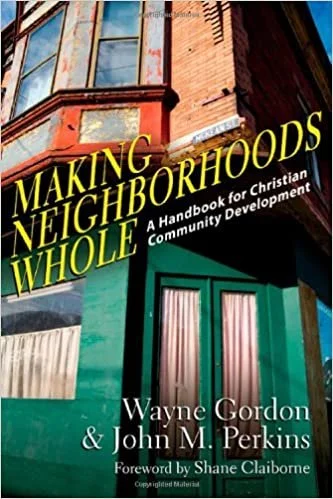Making Neighborhoods Whole
Rock bands like Switchfoot don’t compose tribute songs to just anybody. But when they do, one does well to take note. The band famously memorialized the words—or at least the sentiments—of St. Augustine in the 1999 song “Something More.” And as philosophy professor David Naugle wrote last year in Comment, this was anything but an isolated instance. Rather, he argues, “key aspects of the influential saint’s Christian vision, especially its existential aspects, permeate the band’s lyrics.”
A decade after “Something More” appeared on the album New Way to be Human, Switchfoot paid tribute to another hero on Hello Hurricane. Here is what frontman Jon Foreman had to say about “The Sound (John M. Perkins’ Blues)”:
[It] is a very important song for us as a band. I see so much hatred and fear around me, I see so many people living out their pain. I hear it on the radio. I see it in the headlines. John Perkins story needs to be heard. This song was inspired by a man who sang a louder song than hatred. In a world where we are defined by our differences, Mr. Perkins’s life of service and compassion is a tangible demonstration of what it means to live a life of love. Love is the loudest song we could sing. Louder than racism. Louder than fear. Louder than hatred. John Perkins said it right, love is the final fight. We’re excited to hear this song on the radio, louder than pain.
Perkins, as I’ve said before, is something of a hero for me too, and his books have profoundly shaped my thinking on faith, justice, racial reconciliation, and especially community development. But of course, he’s impacted the lives of many, perhaps primarily through his involvement with the Christian Community Development Association (CCDA), which he helped to establish nearly 25 years ago.
Now, along with Wayne Gordon, a Chicago pastor who led CCDA for many years and now serves as president of the board, Perkins has written Making Neighborhoods Whole: A Handbook for Christian Community Development (InterVarsity Press). The book primarily serves as an overview of CCDA’s distinctives, which may not sound overly compelling, but I found that it does so in a richly engaging way.
Perkins and Gordon begin with a bit of history, including formative moments in their own lives, how their paths eventually crossed, and of course, the story of how CCDA took root, how it has morphed over the years, and where it might be headed in the future. I’ve read several books by Perkins (and one co-authored by Gordon) before, and have been familiar with CCDA for some time. Some of this was therefore review, but I was interested to discover details I’d either never known or forgotten about the remarkably vibrant association they have helped to lead.
The authors then outline the eight core components or hallmarks of Christian community development, taking them a chapter at a time. The first three—relocation, reconciliation, and redistribution—originated with Perkins early on, while the latter five—leadership development, listening to the community, being church-based, a wholistic approach, and empowerment—were added later in collaboration with others. (One or two of those words might raise red flags for some readers of this blog, but I’d encourage you to find out what they mean by them before rushing to judgment.)
Supplementing these eight hallmarks in the book are short essays from a variety of Christian community development practitioners, most of whom toil in obscurity. That is, they’re only household names in the neighborhoods where they actually live and work, where they’re beloved and anything but unknown.
For those already acquainted with the work of CCDA, Making Neighborhoods Whole will help provide context for the organization as it exists today. For those interested in the book who represent broad swaths of evangelicals newly energized by the idea of seeking the flourishing of our cities, but who don’t know much about CCDA, the history chapters might get into some unnecessary minutiae (budget fluctuations and conference attendance year by year, for instance). But the real heart of the book—the chapters and corresponding essays on the hallmarks—will be helpful and interesting, I think, for everyone.
Those with any level of responsibility for or involvement in church or nonprofit ministry among the poor, both domestically and abroad, would find much of value in Making Neighborhoods Whole.
